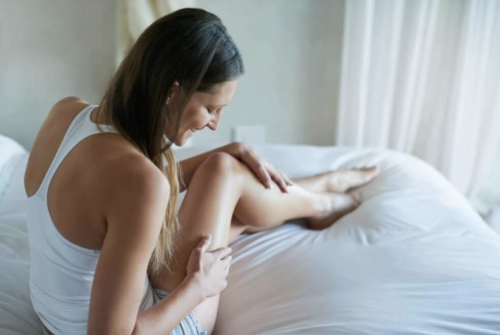Posted August 27, 2019 in Spider Veins, Varicose Veins

Are you embarrassed by bulging purple varicose veins or spindly spider veins on your legs? If so, you are not alone. It is estimated that 30-60% of adults grapple with these conditions, which are much more commonly experienced by women than men. Although they are considered relatively harmless, these unsightly veins may prompt you to avoid wearing skirts, shorts, swimsuits, and other leg-baring fashions.
Double board-certified plastic and general surgeon Dr. Timothy Mountcastle is the founder of Mountcastle Vein Clinic in Ashburn, VA. He is able to expertly explain the similarities and differences between spider and varicose veins in Northern Virginia patients, as well as treatment options that are available at his vein treatment center.
What are varicose and spider veins?
These dilated blood vessels often form in the legs, developing when the valves and walls of the veins become weakened. This prompts blood to pool in the veins, which increases pressure on and causes them to become enlarged. Although the causes and symptoms of varicose veins are similar, the conditions are actually distinct from one another and are addressed as such at our Northern Virginia vein treatment center.
Genetics can increase the risk for women and men to develop vein conditions, including spider or varicose veins. Other causes include obesity, pregnancy, aging, a sedentary lifestyle, wearing high-heeled footwear and restrictive clothing as well as sitting or standing for long periods of time. Now that you know how they are similar, read on to learn what differentiates these conditions.
Varicose Veins
About half of people aged 50 and older are affected by varicose veins. When the muscles in the legs squeeze, it causes blood from the lower body to be pushed back against the forces of gravity toward the heart. The veins feature valves that work to prevent blood from flowing backward as it travels upward. When the valves are weakened or damaged, blood leaks back into the veins and remain there, causing the vein to bulge and become bigger.
Most varicose veins are hormone-related. Oral contraceptives, hormone replacement therapy, and other medications that contain female hormones are known to increase the risk of developing varicose veins. They also can be experienced by those whose work involves sitting or standing during long shifts. This, as well as crossing your legs, can restrict blood flow and worsen their appearance.
Varicose veins can be painful and cause Northern Virginia patients to feel a throbbing, heaviness, or aching in the legs. Cramps and difficulty walking may also be experienced. For others, varicose veins may result in serious health conditions. These can include skin ulcers and sores that develop when the blood in the veins backs up for an extended amount of time. Besides being painful, these may be unable to heal until proper blood flow is restored. Men and women with varicose veins in Northern Virginia may also bleed more easily since the skin over the veins usually is thin. When an injury occurs, the amount of blood that is lost can be significant.
A small percentage of Northern Virginia patients may develop blood clots associated with varicose veins. It is possible for a condition called superficial thrombophlebitis to form in a vein located just below the skin’s surface. Meanwhile, deep vein thrombosis (DVT), which occurs in veins located deep in the leg, can cause pain, swelling, redness, and warmth in the calf, requiring prompt medical attention.
Spider Veins
As the name suggests, spider veins are tiny red, purple, or blue lines that look similar to a spider web or the thin branches of a tree. These veins, which are located just below the skin, usually are 1 millimeter or less. Typically, they are not painful and do not result in swelling of the legs or other health problems. However, it is possible for patients to feel a burning or itching sensation on the skin. The veins may bleed if the skin is scratched too aggressively or if you bump into something. This may also cause a bruise to appear beneath the skin. Besides the legs, spider veins also frequently appear on the face. No matter where they are located, for most patients, they usually are a strictly cosmetic concern.
Treatment options
A variety of procedures can be performed at Mountcastle Vein Clinic in Ashburn, VA to improve or eliminate the appearance of spider and varicose veins. During FDA-approved sclerotherapy treatments, a concentrated saline solution is injected into the veins. Once irritated by this solution, the vein scars, and collapses. Blood flow is rerouted to other veins nearby and the treated vein fades from sight within several weeks of the hour-long procedure.
VeinwaveTM employs a process called thermocoagulation to deliver controlled amounts of microwave energy to the surface of the veins, causing them to collapse and die. When performed at our vein treatment center in Northern Virginia, the 20-minute procedure can work especially well to eliminate the appearance of veins that are extremely thin.
As part of microphlebectomy procedures, sections of varicose veins are excised via small incisions in the skin to remove the vein from view. With blood flow redirected to a vein located deeper in the leg, patients may notice an improvement in their overall blood flow.
Meanwhile, during a VNUS Closure, Dr. Mountcastle accesses the vein through a small puncture and a catheter is inserted to deliver radiofrequency energy. This creates heat that causes the vein walls to collapse and close shut. Blood flow is redirected to healthy veins, and the closed vein eventually is incorporated into the surrounding tissue.
Although they share many similarities, there are distinct differences between spider and varicose veins. Both can leave patients feeling uncomfortable and less confident about the appearance of their legs. Treatment options are available at Mountcastle Vein Clinic in Ashburn, VA. Schedule an appointment with double board-certified plastic and general surgeon Dr. Timothy Mountcastle to learn more.